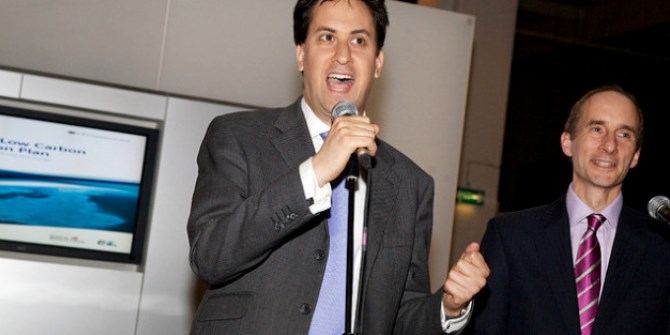
 Though the three main Westminster parties have each publicly rejected a formal currency union with an independent Scotland, Alex Salmond and the ‘Yes’ campaign have yet to articulate what a ‘plan B’ would entail. In this article, David McCarthy and Angus Armstrong lay out the options in detail, writing that the limited ability of an independent Scotland to provide ‘lender of last resort’ support to its banking system means that both regulatory and market action will lead the two remaining significant Scottish banks to redomicile.
Though the three main Westminster parties have each publicly rejected a formal currency union with an independent Scotland, Alex Salmond and the ‘Yes’ campaign have yet to articulate what a ‘plan B’ would entail. In this article, David McCarthy and Angus Armstrong lay out the options in detail, writing that the limited ability of an independent Scotland to provide ‘lender of last resort’ support to its banking system means that both regulatory and market action will lead the two remaining significant Scottish banks to redomicile.
It seems likely that if the Scottish referendum succeeds, Scotland will continue to use the pound sterling in an informal currency union with the UK. Scottish leaders have not indicated exactly what this so-called ‘Plan B’ means. (‘Plan A’, a formal currency union, has been rejected by the UK).
An independent Scotland has three main ways to continue to use the pound sterling: to remove the Scottish notes from circulation entirely and use notes issued by the Bank of England (called pure dollarization); to continue with the current currency arrangements, where Scottish banks issue their own notes, which are fully backed by UK pound notes and/or sterling-denominated securities held either in vaults in the Bank of England (or, more likely, at a Scottish monetary authority); and to create a new currency, called the Scots pound, pegged one-for-one to the pound sterling, whose convertibility will be guaranteed by a currency board which will hold sterling backing assets for every Scots pound note issued. Under all options, it is likely that pounds sterling will continue to be widely used in Scotland, so at best, Scotland will operate a parallel currency regime.
The implications of an informal currency union for monetary policy and government finance
Under all currency options, Scotland will lose the ability to run an independent monetary policy, so interest rates in Scotland will follow interest rates set in London. As the UK and Scottish economies are aligned, this is not likely to be a serious problem. But, as in the Eurozone, it could create difficulties if they are not.
The stock of domestic currency in Scotland will depend on capital flows into and out of Scotland – called the balance of payments. Scottish exports will depend heavily on oil revenue, which can be unstable (although most oil company profits are exported too; a natural hedge). When domestic liquidity is in large supply, the Scottish monetary authority could soak up the surplus liquidity by borrowing money domestically and lending it abroad. But when liquidity is short, it will have to borrow abroad and lend domestically. The first is easy; the second depends on the willingness of foreign creditors to extend loans to Scotland.
An independent Scotland will be a heavily indebted country (estimates of explicit debt hover around 90 per cent of GDP; implicit debt in the form of unfunded civil service pension funds is at least as large again). This existing debt – and any new borrowing – will be denominated in a foreign currency. Just to pay its existing debt, the Scottish government will need to raise large amounts of foreign currency on a regular basis, more if it chooses to run fiscal deficits.
The implications of an informal currency union for the Scottish banking system
Modern fractional reserve banking systems are inherently unstable. Banks are subject to liquidity risks as they take deposits and borrow money over the short term, and lend it out for longer periods. Banks – and whole banking systems – may be subject to self-fulfilling crises of confidence if depositors and creditors lose confidence the ability of a bank to honour its liabilities and rush to cash in their deposits or loans. The risk may spread from bank to bank, or from the banking system to the sovereign, and vice versa, or from one country to another, through a process called contagion. Modern central banks aim to prevent and curtail contagion by providing emergency liquidity to troubled banks, or indeed, to the entire banking system. In general, it cannot be said that a bank with a liquidity problem is solvent until after the fact. Thus, ‘liquidity assistance’ often ends up being a form of solvency assistance. We therefore lump liquidity and solvency support together and call them ‘lender of last resort’ (LOLR) assistance.
The amount of liquidity that an independent Scotland could provide to its banking system is limited to the amount that Scotland holds in foreign reserves, or the amount that Scotland could borrow abroad. In a banking crisis, Scotland would therefore be dependent on foreign creditors to ensure that it could provide liquidity to its banking system. This is not a new problem: during the era of fixed exchange rates, the IMF was created precisely to provide LOLR assistance to countries during crises. Over time, and with the demise of the Bretton-Woods system, the role of the IMF has broadened, and other international agencies have emerged.
Options for Scotland
So what options does Scotland have to provide LOLR support to its banking system? Three, really. It could build up reserves, either on the state’s balance sheet by running large fiscal surpluses, or on the balance sheet of the Scottish Monetary Authority, or in a separate insurance or financial stability fund, by accumulating balance-of-payments surpluses. Given what we know about the fiscal and balance-of-payments position of Scotland, this appears implausible.
Secondly, Scotland could borrow money from international creditors. Various creditors are possible – the IMF, the European Union, and the Bank of England might all be willing to play a role. (International banks might lend money but could exacerbate a crisis by trying to hedge their positions). But international creditors require sovereign guarantees, and will impose terms of conditionality in exchange for support which may be unpalatable. Commercial banks who provide lines of credit in advance will hedge their exposure during a crisis, worsening outcomes (as happened to Argentina in 2002).
Finally, Scotland could try and transfer the risk onto a third party. We were unable to find examples of such an international risk transfer. One option might be the Bank of England, which could write ‘liquidity options’ to Scottish banks in exchange for a premium received in advance. (This is an extension of an idea suggested for UK banks by Bill Winters in a recent review of the Bank of England’s liquidity operations). There are practical issues which make such an option unlikely. ‘Fair’ premiums will not be sufficient to control moral hazard, and will be uncollectible in practice. So to prevent moral hazard, the Bank of England would have to become the de facto regulator of Scottish banks, and the insurance would have to be made mandatory (creating vulnerabilities for Scotland). Most importantly, it is unclear how this arrangement could be made consistent with the Bank of England’s mandate to uphold the interests of UK (as distinct from Scottish) consumers and taxpayers. A second option – joining the European Banking Union – will only provide true risk sharing after a bank has defaulted, through the Single Resolution Fund. Even inside the Eurozone, the ECB provides liquidity support but risks remain firmly with member states until banks actually default.
The outcome
The limited ability of an independent Scotland to provide LOLR support to its banking system means that both regulatory and market action will lead the two remaining significant Scottish banks to redomicile. Since one of Scotland’s largest exports is financial services, this will significantly affect Scotland’s balance of payments surpluses. A small and largely domestic banking system will remain. Scots will rely on branches of international banks for banking services.
Note: This article gives the views of the author, and not the position of the British Politics and Policy blog, nor of the London School of Economics. Please read our comments policy before posting. Featured image credit: Howard Lake CC BY-SA 2.0
 David McCarthy graduated with a PhD from the Wharton School of the University of Pennsylvania in 2002. He has worked at Oxford University and Imperial College, London. While at Imperial College he started a highly innovative MSc in Actuarial Finance. In 2011 he took an academic sabbatical to assist the South African National Treasury with the design of reforms to the South African retirement system. Since 2013 he has been a Visiting Fellow at the National Institute for Economic and Social Research in London.
David McCarthy graduated with a PhD from the Wharton School of the University of Pennsylvania in 2002. He has worked at Oxford University and Imperial College, London. While at Imperial College he started a highly innovative MSc in Actuarial Finance. In 2011 he took an academic sabbatical to assist the South African National Treasury with the design of reforms to the South African retirement system. Since 2013 he has been a Visiting Fellow at the National Institute for Economic and Social Research in London.
 Angus Armstrong is Director of Macroeconomic Research and the National Institute of Economic and Social Research.
Angus Armstrong is Director of Macroeconomic Research and the National Institute of Economic and Social Research.








Why would fund management and other financial services re-domicile? Could you cite sources for the importance of investment vs retail banking to Scottish exports and tax revenue? Thanks.